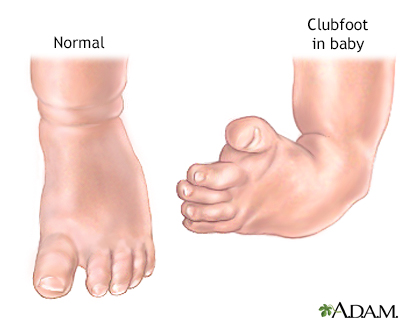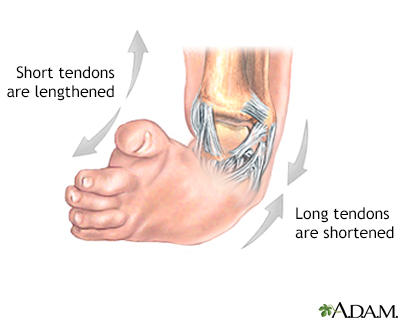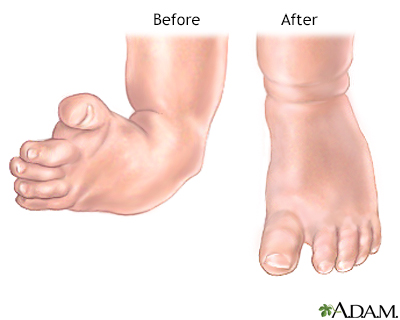Clubfoot repair
Normal anatomy
|
|
The normal position of the human foot is such that the sole of the foot is flat against the ground while walking. Clubfoot is a congenital abnormality in which the foot is adducted (angled inward). Correction of clubfoot is required for normal ambulation later in life.
|
Procedure, part 1
|
|
The newborn baby's deformed foot is initially treated with casts. The tendons, ligaments, and bones are still quite flexible and easier to reposition. The foot is stretched into a more normal position and a light-weight cast is applied to retain the corrected position. The cast will be removed every week or two so the foot can be further stretched into better position and maintained with a new cast. This serial casting is continued for three or more months and is successful in at least 50% of cases. If the casts do not provide enough correction of the clubfoot, surgery is considered.
|
Procedure, part 2
|
|
The type and extent of surgery depends on the how severe the deformity is. The defect involves tight and short tendons around the foot and ankle. The surgery involves lengthening some tendons and shortening other tendons to place the bones and joints in normal positions. A cast is applied to the foot after surgery to maintain its position while it heals.
|
Aftercare
|
|
The child will stay in the hospital for approximately two days after surgery. The foot will be casted and kept elevated, with ice packs used to reduce swelling and pain. Medications can be used for pain. The skin around the cast and the toes will be checked frequently for the first 48 hours to make sure that the circulation, movement, and feeling are maintained.
Before leaving the hospital, the parent will be taught how to take care of the cast, which is usually left on for about three months. Skin irritations from the cast or incision infections may occur. Physical therapy is usually required after the cast is removed to strengthen the muscles in the repaired foot.
|

Review Date:11/6/2023
Reviewed By:Neil K. Kaneshiro, MD, MHA, Clinical Professor of Pediatrics, University of Washington School of Medicine, Seattle, WA. Also reviewed by David C. Dugdale, MD, Medical Director, Brenda Conaway, Editorial Director, and the A.D.A.M. Editorial team.
The information provided herein should not be used during any medical emergency
or for the diagnosis or treatment of any medical condition. A licensed medical professional
should be consulted for diagnosis and treatment of any and all medical conditions. Call 911
for all medical emergencies. Links to other sites are provided for information only -- they
do not constitute endorsements of those other sites. © 1997-A.D.A.M., Inc. Any duplication or distribution of the information contained herein is strictly prohibited.
The Agency for Health Care Administration (Agency) and this website do not claim the information on, or referred to by, this site is error free. This site may include links to websites of other government agencies or private groups. Our Agency and this website do not control such sites and are not responsible for their content. Reference to or links to any other group, product, service, or information does not mean our Agency or this website approves of that group, product, service, or information.
Additionally, while health information provided through this website may be a valuable resource for the public, it is not designed to offer medical advice. Talk with your doctor about medical care questions you may have.




